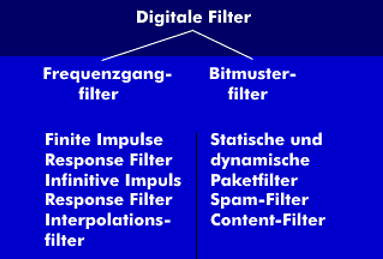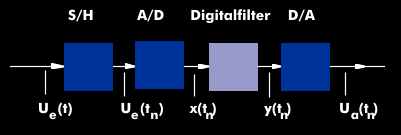digital filter
Digitalfilters are divided into those that emulate the frequency response of an analog filter and those that analyze bit patterns. These can be packet filters, spam filters, Bozo filters, text filters, upload filters or content filters.
Digital filters, which emulate an analog filter, perform arithmetic operations on digitally available numerical values of a data stream, which lead to a change in the frequency components. Compared to analog filters, they have the advantage that they can also emulate filter curves with extreme slopes, which in analog filters leads to runtime problems and phase shifts between the different frequencies.
Digital filters consist of reference tables derived from the filter characteristics of analog filters. For this purpose, the frequency and attenuation values of the analog filters are captured as discrete values, digitized and transferred to the reference table. To capture the filter values, the filter is swept or driven with discrete frequencies. The corresponding filter output signal is then digitized. The digital reference values obtained in this way are entered in the reference table. The output values of digital filters are then formed via interpolation by interpolating between two amplitude values.
The structure of digital filters
Digital filters are made up of several components. These include delay elements that delay the sampling interval. As a result, the output of the input signal is delayed by one clock interval. If the signals are calculated in a loop in the computer, then the delay links also form the intermediate memories. Another component is the multiplier. It provides for the multiplication of the input signal by a gain constant. And the third component is the adder. It provides for the summation of two input signals.
The use of digital filters is similar to that of analog filters: The input signal to be filtered is sampled in a sample-and-hold (S/H) circuit and is available to the downstream A/D converter as an analog voltage value. This digitizes it and passes the digital data stream to the digital filter, where it is treated mathematically accordingly. The resulting data stream is converted back into an analog output signal in the downstream D/A converter. The conversion in the digital filter is discrete in value, that of the digital filter and D/A converter is discrete in amplitude, and that of all three assemblies is discrete in time.
There are various methods for digital filters, the best known are based on Finite Impulse Response( FIR), which stands for finite impulse response, and Infinite Impulse Response( IIR), which stands for infinite impulse response.


